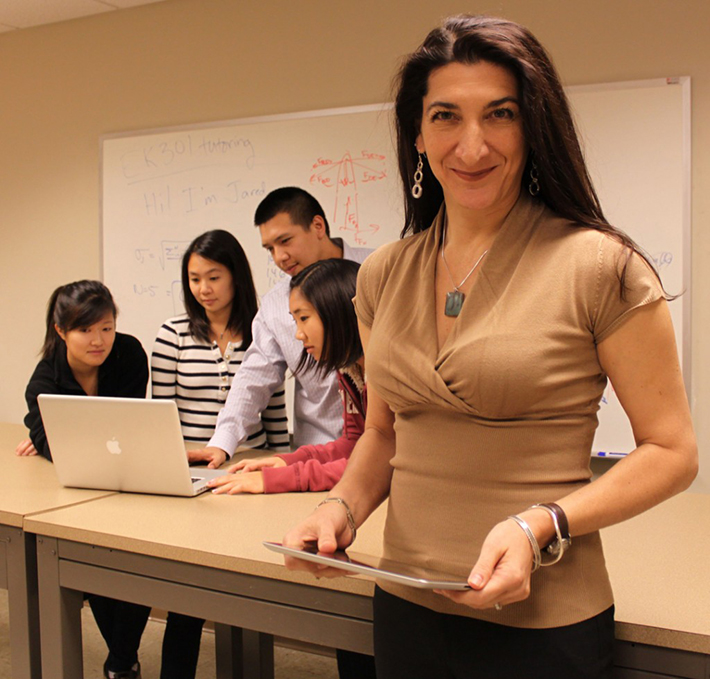On Aug. 25, the George Washington University will launch its first-ever Massive Open Online Course (MOOC), titled "Practical Numerical Methods with Python"—developed through an innovative collaboration between GW's School of Engineering and Applied Science (SEAS) and three other institutions across the world.
The 12-week, non-credit MOOC is led by Lorena A. Barba, an associate professor in the Department of Mechanical and Aerospace Engineering. Dr. Barba will be teaching the same content in a credit-bearing course at GW that will uniquely combine face-to-face instruction and online learning. All students in her on-campus course (MAE6286) will simultaneously be enrolled in the MOOC.
This MOOC, aimed at first-year graduate engineering students and advanced college seniors, is free to the public and open for registration. It will provide a foundation for tackling modern computational modeling problems using the programming language Python. Rather than using an outside MOOC provider, GW will offer the course independently through its own instance of the Open edX software on cloud hosting services.
GW’s foray into MOOCs is intended to empower faculty who are interested in exploring the use of technology to reach a broader, international audience, said Paul Schiff Berman, vice provost for online education and academic innovation.
“In addition, as a university, it is part of our service mission to provide educational opportunities to people throughout the world in subject areas that are either distinctive strengths of GW or where we can create an approach that is not already being produced in the market,” he said.
Dr. Barba will co-teach the course with faculty from King Abdullah University of Science and Technology in Saudi Arabia, the United Kingdom’s University of Southampton and the Pontifical Catholic University of Chile. The MOOC is supported by GW Academic Technologies, SEAS, the university’s eDesign Shop and the Office of the Vice Provost for Online Education and Academic Innovation.
Instructors from each university will collaborate in the design and implementation of the course’s content and learning objectives. At the same time, each instructor will offer a credit-bearing, blended-learning course on his or her respective university’s campus. Students in the on-campus courses will participate with the MOOC community through discussion boards and online activities.
“We understand creating knowledge as forming connections—between concepts, between people, between students’ ideas and course content. The more diverse the community, the more chances there are for these connections to happen.”
—Lorena A. Barba, associate professor of mechanical and aerospace engineering
The course will incorporate videos (all will also be available on YouTube), short quizzes and content offered through iPython notebooks. The goals of the MOOC are to provide the skills for students to identify the best method for solving a problem, to write a correct computer program to implement that method, and finally, to interpret numerical solutions.
The MOOC will be divided into seven modules, allowing students to complete mini-lessons at their own pace, with no expectation that they need to complete the entire course.
“It’s a more granular approach to teaching, and it keeps the students engaged,” Dr. Barba said.
Inspired by the philosophy of open-source software, Dr. Barba said one of the main tenets of the course is that the Internet can be used to interact, connect our learning and share knowledge. The course will give students room to be creative with the learning material and to engage with one another through discussion.
“The idea of the larger community is powerful,” Dr. Barba said. “We understand creating knowledge as forming connections—between concepts, between people, between students’ ideas and course content. The more diverse the community, the more chances there are for these connections to happen.”
"Practical Numerical Methods with Python" is one of several MOOCs that will be offered at GW in the future.
The next MOOC set to launch will examine the history, philosophy and processes of the Federal Reserve. Currently in production, the MOOC will include participation from major figures within the Federal Reserve and in the political and banking communities. Other MOOCs, including one on patent law and policy, are planned to begin in 2015.
Vice Provost Berman stressed that MOOCs are a small part of what GW is doing in the online education space. Most GW online education courses are part of tuition-based, degree-granting programs, and they are operated at a smaller scale, with a low student-faculty ratio.
“I don’t believe that MOOCs, because of their large scale, will replace either in-person education or smaller scale online education anytime soon,” he said. “However, I think it’s important to provide an opportunity for professors to explore MOOCs if they choose to, and I also believe that it is useful for GW to use MOOCs to highlight areas of strengths throughout the university.”
Experimenting with various forms of online education may help the university with all of its online efforts as well as aid in the development of innovative teaching approaches on campus, he said.
Dr. Barba does not have an expectation for how many users will register for her MOOC, but after only 24 hours of open registration,150 participants signed up. Excitement buzzed around Twitter after she sent a tweet announcing the course, and the #numericalmooc hashtag was born.
She said she knows that developing and teaching her first MOOC may come with its challenges, but she is looking forward to creating a collaborative, learning community. And while the “initial hype of MOOC disruption” may be dying down, she called this particular course a “breath of fresh air.”
“It is independent, collaborative, modularized and really open,” Dr. Barba said. “Because in online education, there is still room to be inventive.”


